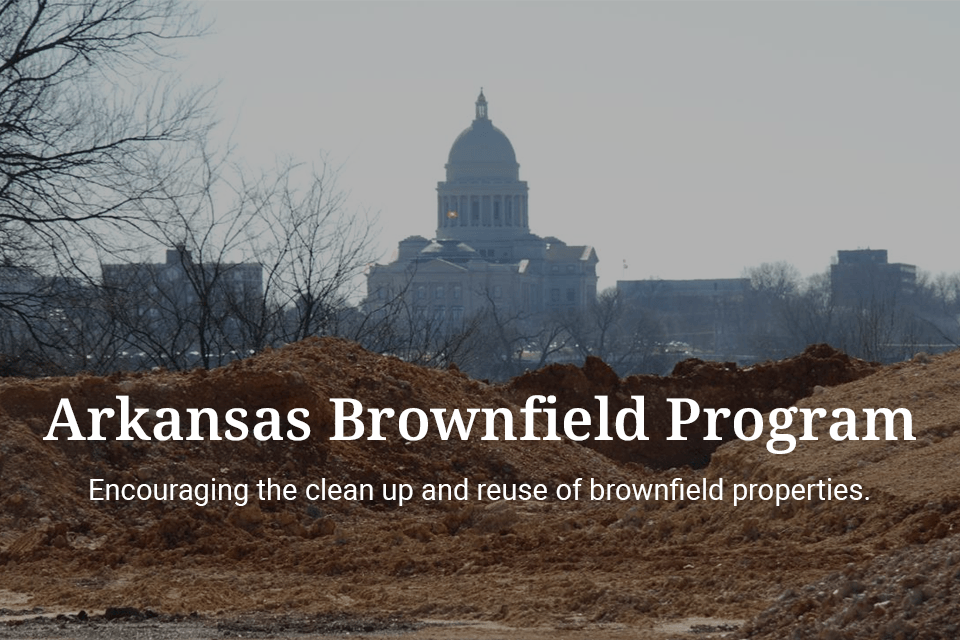Arkansas Brownfield Program
The “Brownfield Economic Redevelopment Initiative” was announced by U.S. Environmental Protection Agency (EPA) Administrator Carol Browner in November 1994 as part of the EPA Region 6 Brownfield Program. The objective of the Initiative is to return unproductive, potentially contaminated properties back to beneficial use, to define the financial liabilities associated with a cleanup early in the process, and to ensure environmentally sound redevelopment in the future.

In 1995, the Arkansas Brownfield Law (Act 125) was enacted with a great deal of support and enthusiasm by both political parties in the Arkansas Legislature. DEQ began receiving federal funds from EPA to begin program development soon thereafter. In 1996, external and internal work groups were formed to develop cleanup standards, guidance, and policy. In 1997 several amendments to the Brownfield Law were adopted by the Arkansas Legislature, again with overwhelming bipartisan support. The amendments (Arkansas Code Annotated § 8-7-1101 et seq.), which became effective in August 1997, expand the types of properties that qualify for the program, further limit financial liability for purchasers of Brownfield properties, and provide for low-interest loan program to be established for participants in the program.
In December of 2000, EPA and DEQ entered into a Memorandum of Agreement (MOA) to support DEQ’s Brownfield Program and define the roles and responsibilities of EPA Region 6 and DEQ.
Further information about the Arkansas Brownfield Program can be found in APC&E Commission Regulation 29.
Select the plus symbol
 to view instructions relating to your selection.
to view instructions relating to your selection.
A brownfield is a parcel of property where commercial, industrial, or agricultural use may have contaminated the site with a hazardous substance, thereby complicating prospects for expansion, redevelopment, or reuse.
Individuals, companies, or real estate developers who did not contribute to the contamination and who do not hold title to one of these abandoned properties may enter into an agreement with DEQ for the cleanup.
Based on the terms of the agreement, the purchaser of the property will be able to define the financial obligations early in the process and will not be held liable for past contamination after the cleanup is complete. Lending institutions will also be able to quantify financial risks associated with a contaminated property.
- To provide continued protection of human health and the environment
- To encourage redevelopment as a sound land-use management policy
- To develop risk-based cleanup standards
- To enable prospective purchasers to determine liability “up front”
- To develop a schedule-oriented program that can keep pace with real estate transactions
- Technical Assistance for Assessments: DEQ offers its assistance to qualified nonprofit or public Brownfield Program Participants for environmental site assessments. For more information, please read the Targeted Brownfield Assessments information below.
- EPA Grants: For information on funding available by the U.S. Environmental Protection Agency, please visit their website.
Targeted Brownfield Assessments
Funded by awards granted by EPA, DEQ has the opportunity to offer technical assistance for site assessments to qualified Brownfield Program participants belonging to either the nonprofit or public sector. Targeted Brownfield Assessments (TBA) are designed to help minimize the uncertainties of contamination often associated with brownfields. A TBA may encompass one or more of the following activities:
- A Phase I Environmental Site Assessment, including a background and historical investigation and a preliminary site inspection
- A Comprehensive Site Assessment (CSA), including sampling activities to identify the types and concentrations of contaminants and the areas of contamination to be cleaned
TBA funding may only be used at sites as authorized by the Comprehensive Environmental Response, Compensation and Liability Act (CERCLA) of 1980, as amended by the Superfund Amendments and Reauthorization Act (SARA) of 1986. The site must be contaminated or suspected to be contaminated with hazardous substances. Sites contaminated only with petroleum products are not eligible for assistance at this time.
To apply for TBA assistance, please view the Brownfield Assessment Request Letter Guidance or contact the DEQ Brownfield staff at 501-682-0872 or brownfields@adeq.state.ar.us for more information.